AMAMI OSHIMA: Isson's Treasure Island
Tanaka Isson, an artist known as Japan's "Gauguin," moved to the subtropical island of Amami Oshima at the age of 50 after years of struggle. He then spent highly productive years there painting its striking flora and fauna until his death at the age of 69. In order to follow in Isson's footsteps, Peter Barakan travels to Amami Oshima, where, in addition to many unusual biological treasures, he discovers how the distinctive cultural traditions of Amami Oshima were shaped by a history of hardship.
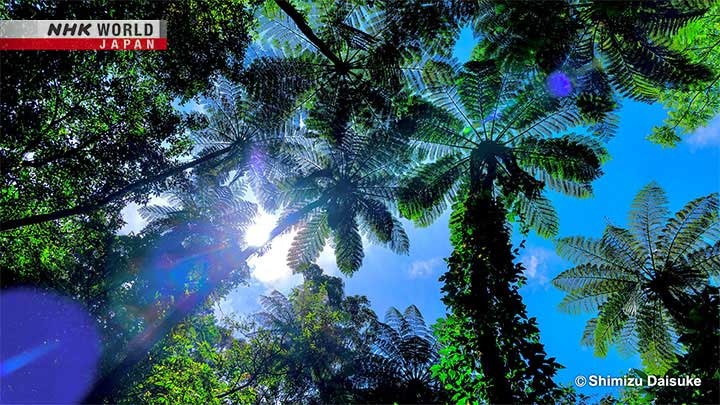
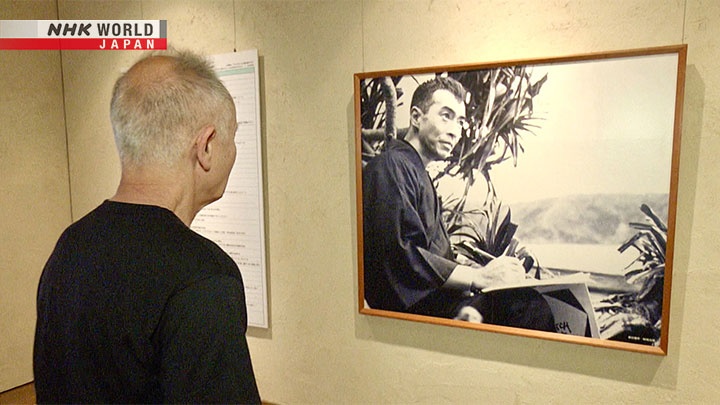
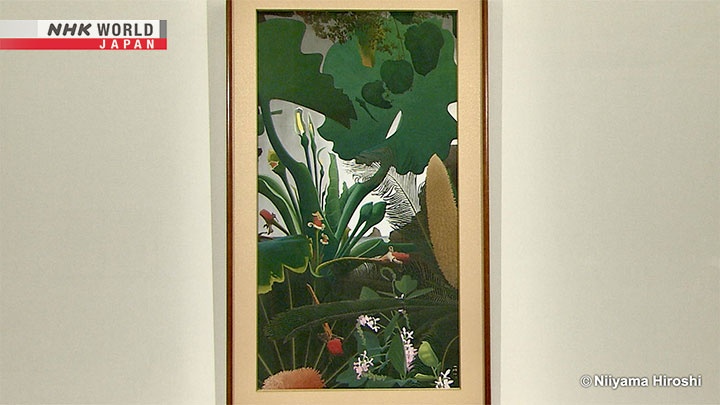
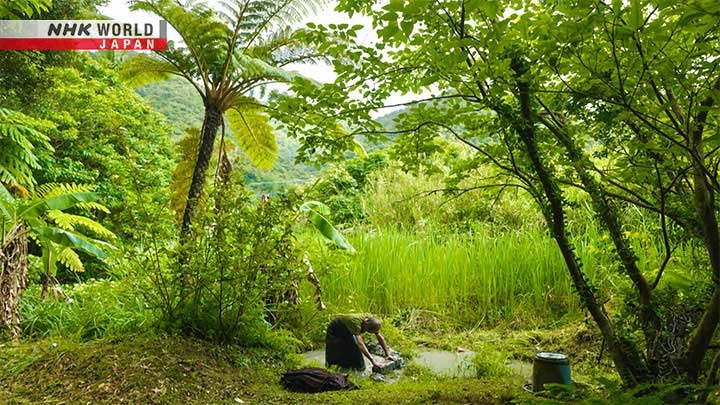
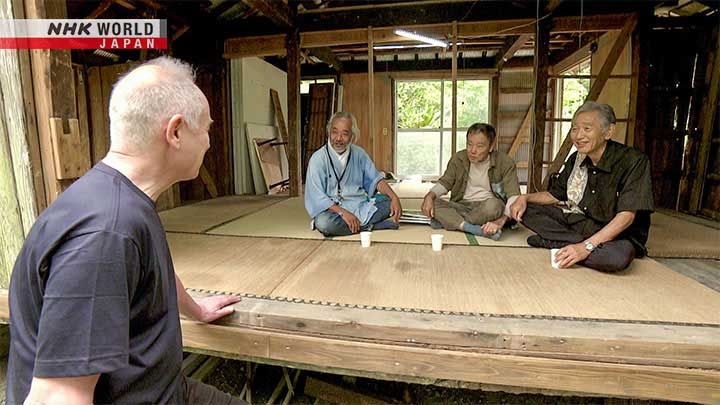
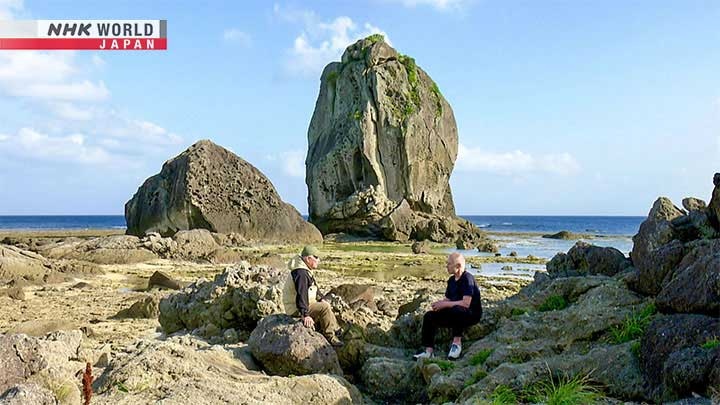
Transcript
Lush subtropical foliage, presented in muted greens.
And an eerie, almost otherworldly atmosphere.
I just love this picture.
It was painted by Tanaka Isson, sometimes referred to as the Japanese Gauguin.
He was dressed strangely.
I thought he was a weird old man.
I met him in passing.
And I remember his piercing gaze.
Isson lived alone, in poverty, and died in obscurity.
He spent the last 19 years of his life painting the flora and fauna of a remote island in southwest Japan.
Amami Oshima. I'd been wanting to visit this place for several years...
Ever since seeing Isson's work for the first time.
I visited people and places associated with him,
and caught a glimpse of the forest and local way of life through his eyes.
This was painted by Isson.
It's my great-grandparents.
What did this solitary artist discover in Amami Oshima?
Amami Oshima is around 1,200 kilometers southwest of Tokyo.
80 percent of the land here is covered in subtropical vegetation.
Near the middle of the island is one of Japan's largest mangrove forests.
This spectacular natural environment is home to many rare and endemic species.
The surrounding sea is said to be "Amami Blue," and coral reefs showcase a kaleidoscope of colors.
Hello, I'm Peter Barakan.
I've been in Japan for nearly 50 years.
I work as a broadcaster, but I also do a lot of DJ events around Japan,
and one day I received an invitation from Amami Oshima.
That's how my dream of visiting this island became reality.
But that was not my only reason for wanting to come here.
For me, it was also a chance to learn about the enigmatic artist who moved here
and created such striking images of its natural world: Tanaka Isson.
Isson makes skillful use of color to present shadowy areas amid bright light.
The plants have a quiet vitality.
This art generates a mysterious atmosphere that I find captivating.
Because of the paintings, I kind of wanted to see what kind of a place Amami Oshima was,
in that, it had obviously triggered something in him to create this amazing art.
Here at last.
The permanent exhibition here traces Isson's journey from childhood to the end of his life.
Oh, here it is.
I've seen this so often in photographs.
I hadn't realized it was quite this big.
This is kind of the reason I'm here.
"Alocasia and Sago Palm" is considered the culmination of Isson's creative endeavors.
The artist himself saw it as the work by which he would like to be judged in the life hereafter.
Do you think that Isson would actually have seen that in this view, just the way it is in the picture?
Well, he painted this
towards the end of his life.
It brings together elements
associated with life and death.
So I think it communicates
his own sense of mortality.
This made me wonder what kind of life Isson had lived.
His talent was obvious from a young age.
Nine? Wow.
He was evidently very precocious.
Isson was a child prodigy.
He painted this at the age of seven.
It's said that after his father - himself a sculptor - made changes, Isson angrily tore part of it off.
He was clearly already confident in his ability.
People quickly noticed his talent.
His work began to draw many fans.
In 1926, he was admitted to Japan's top school for artists.
But he soon dropped out.
Some say it was because of a family illness.
But it's also possible that he believed there was nothing there for him to learn.
Isson's family needed money, but he himself was increasingly reluctant to paint commercially.
In Isson's case, it appears that he didn't particularly want to sell his work.
What was the reason for that?
He didn't enjoy simply painting
what customers wanted.
He wanted to paint from the heart.
At the age of 23, Isson produced this.
It reflects no regard for the preferences of his customers.
When his patrons saw it,
their opinion of him changed.
They turned their backs on him.
And Isson entered
a difficult period of his life.
At the age of 30, he moved to a village in Chiba Prefecture, adjacent to Tokyo.
He earned a living through farming and part-time work, but continued to paint.
He had always been somewhat frail, but the war years starting in 1941 took a particularly heavy toll on his health.
However, that didn't diminish his passion for art.
At the age of 39, he painted this.
Every leaf and flower reflects meticulous attention to detail.
He submitted it to a public exhibition showcasing innovation in traditional Japanese art - and it was accepted.
I'd like to show you this one next.
Oh wow. This is a big change again, isn't it?
Isson's skill and creative energy are again evident in this ambitious piece,
painted on a folding screen covered in gold leaf.
Brimming with confidence, Isson submitted it to another exhibition.
Isson was convinced
his piece would be selected.
But things didn't turn out
that way. It was rejected.
Really? So was he very disappointed about that?
Rather than disappointed,
he was furious.
He wrote a letter of complaint
to the organizers.
In it, he demanded to know
why his work hadn't been accepted.
But Isson's complaints were not heard.
As a result of this incident, he cut ties with Japan's mainstream art establishment.
Even as his circumstances became increasingly difficult, he continued to paint.
Nevertheless, he needed some kind of breakthrough, a fresh source of inspiration.
And he decided to hit the road.
He went to Kyushu, in southwest Japan.
Its vibrant, colorful scenery was new to him, and it prompted a further change in his painting style.
Isson was particularly taken with the small island of Aoshima.
The vegetation he saw there left a lasting impression.
Here's a painting he produced in 1955, at the age of 47.
This paper was used to wrap the painting, and on it, he wrote down a few thoughts.
"Turquoise sea. Sapphire sky. Fluttering palm fronds."
"It's like a tropical dream."
His journey instilled a strong desire to go even further south.
And in 1958, at the age of 50, that's what he did.
Isson moved, alone, to Amami Oshima.
After arriving, he started taking photos of plants and animals that he was seeing for the first time.
These would become the new motifs in his work.
I went to see some of the plants for myself.
Kijima-san. Nice to meet you.
Kijima Kosuke is an ecotour guide.
He took me into the forest.
Did you ever meet Isson?
Yes, back when I was a teenager.
He looked strange.
He was wearing a very rough,
informal outfit.
I thought he was a weird old man.
I was something of
a rebel at the time.
I passed him when I was riding
my bike to my friend's house.
He looked right at me.
And I remember his piercing gaze.
In Amami Oshima, Isson was able to focus single-mindedly on his art.
He often went into the mountains searching for subject matter.
It seems he would closely observe plants and birds.
That's the rurikakesu.
It just called out.
I can't hear it now. Oh, that?
That's the rurikakesu?
- Yes.
- The Lidth's jay.
We might be able to see it.
It's kind of a blue color, yeah?
Yes.
Lidth's jay is found only in the Amami islands.
It's one of the many rare species living in the forest here.
Isson clearly loved the colorful, subtropical birds he saw.
They featured prominently in his paintings.
Just here.
This is an endemic plant.
"Calanthe amamiana."
It has pink flowers.
This plant, too, is endemic.
In Amami Oshima, it's common.
The flowers of the Heterotropa lutchuensis grow close to the ground.
It's said to take a hundred years for this plant to spread just one meter.
Look up here.
It's a great place to enjoy
the brush pot trees.
Yeah it is. That's really pretty.
The trees grow tall, up towards the light.
This tree, meanwhile, is known for its roots.
There's not much room for them in the shallow soil.
But in this unusual form, they can support the trunk.
Isson often painted these.
"Mussaenda parviflora."
It has white sepals, and will produce
yellow, star-shaped flowers.
It often appears in Isson's work.
Sepals and petals float
on a green background.
The plant has a nice curve to it.
Isson liked painting that, too.
White amid green.
I think he wanted to show that white
against the green forest background.
Each plant in Isson's art, no matter how small, conveys a strong sense of vitality.
Isson lived on the outskirts of Naze, in what is now the city of Amami, the largest urban community in Amami Oshima.
He arrived just five years after the island had reverted to Japanese administration,
having been occupied by the US after World War II.
Everyday life was changing quickly.
After the war, this place sprang up as a black market, bustling with shoppers.
It retains a sense of those days.
- Hello.
- Hello.
This is a very old marketplace.
It is. When I opened this stall,
the market was already 50 years old.
I used to come to the market
with my grandmother.
All my favorite foods
would be piled up.
Buying them and taking them home
remains an important memory for me.
People would collide with each other
as they moved through the market.
- Collide?
- Yes! Collide, and dodge.
That's how busy it was.
Exactly. There were
lots and lots of shops.
It seems that many island residents move there from elsewhere.
- Are you an Amami native?
- No, I'm from Tokyo.
- Ah, you moved here.
- Yes, for the surfing.
- Huh?
- I came for the surfing.
Local farmers give me vegetables.
That makes everyday life so easy.
Everyone here is so kind.
For a long time, Isson lived in the Ariya district.
The natural world feels very close here.
He lived frugally, growing vegetables in the garden of a small, rented house.
He largely avoided other people and just focused on his art.
It was a very productive period.
Isson made one painting after another.
When he ran out of money, he'd work at a dye workshop.
And when he'd earned enough, he'd quit to concentrate on his painting again.
Oh, and this is where his very last house...
I think it's been moved here.
And he only lived here for ten days, I think.
He moved into this new place...
finally he got a residence that was slightly better than the one he'd been in for so long.
Ten days later he dropped dead of a heart attack.
So... so this is the house.
Good morning.
Isson lived in solitude - but today, a large group has gathered at his old home.
- Excuse me. Do you have a moment?
- Sure.
- Do you like drawing?
- Yes.
- What are you drawing now?
- This flower.
Isson's paintings of plants and birds
really capture the Amami spirit.
They made me fall in love with art.
This event was arranged by the Isson museum.
To the local children, Isson is a familiar figure.
His work inspires them to paint and draw.
It was only after his death that Isson became a household name.
An exhibition arranged by neighbors proved unexpectedly popular, and triggered the growth of his reputation.
I met people who organized that first exhibition.
Hello, good morning.
Hello.
I'd like to ask you a little bit about Tanaka Isson.
People came multiple times,
bringing friends and family.
The event lasted just three days,
but we had about 3,000 visitors.
This isn't a big community.
We could hardly believe it!
A totally unknown painter, yeah?
Totally unknown.
But his paintings were powerful.
They drew people in
over and over again.
Most didn't know about Isson.
It was their first encounter.
He depicted very familiar plants.
You see them all the time.
Some are a nuisance for farmers!
Seeing them in works of art
took everyone by surprise.
But islanders just loved them.
As he said, many people went
to the exhibition more than once.
What is the attraction of his... him and his work for each of you?
It was a period of economic growth.
In those days, it was difficult
simply to follow your own path.
I think he knew he wouldn't achieve
recognition within his lifetime.
He gave up on selling work,
or achieving fame.
In those later years,
he found his true calling.
That's how I see it.
Isson died here alone, with no one to take care of him.
But his legacy is now in safe hands.
The dye workshop where he was employed produced Oshima Tsumugi, a fabric from Amami with 1,300 years of history.
A characteristic of this craft is that the threads are dyed before they are woven.
When carefully combined, a pattern emerges.
One striking feature is a glossy black.
It's produced using a local tree that's rich in tannin.
The wood of that tree imparts a brown color.
This process hasn't changed in centuries.
Next, the threads are dyed in muddy water with a high iron content.
The iron reacts with the tannin to turn the brown to black.
The work demands fine judgment and exceptional manual dexterity.
Making a kimono like this can take a full year.
Isson worked alongside many other artisans.
I met a descendant of one of his co-workers.
This is where the workshop was.
Isson would arrive
from that direction.
He told one workmate
he'd give her a painting.
One day, he said,
it'll be worth a fortune.
But she wasn't interested.
She turned it down.
When he became famous,
she regretted that decision!
I heard that story from
someone around here.
Tamotsu-san's mother worked with Isson, and the family home contains a valuable memento.
Excuse me.
This was drawn by Isson.
Well, it's a replica actually.
It's my great-grandparents.
Tamotsu-san's mother asked Isson to draw her grandparents,
and also her brother-in-law, who died in the Second World War.
These pictures are rare examples of "portraits" by Isson.
We display photos of
our deceased relatives.
But this was before photography
became widespread.
There was only a small photo,
not big enough to put up.
So my mother asked for Isson's help.
He only did that for people he liked.
Isson thought that the eyes were
the key element of a portrait.
I think he took some liberties
with her clothing.
It's a bit surprising.
It almost feels like he's alive.
He's kind of staring down at you.
I mean, it's a very realistic depiction of a person, but there's something really strong about it.
I came home after 30 years
and found it in a drawer.
A valuable picture by Tanaka Isson.
You'd expect it to be on display, but no.
My mother probably just wanted
to help Isson financially.
Basically so that he would get some extra pay in?
The daily wage was 450 yen.
She paid 3,000 yen.
A week's wages.
This is my mother. She asked
her workmate to draw pictures.
And those pictures became
treasured family heirlooms.
These portraits really bring out the personality of the featured people.
It's time for my DJ gig.
This time they've given me a theme of work songs.
And I'll just wing it and play as many as I can within the allotted time.
I came to Japan from London almost 50 years ago.
At first everything was new and invigorating, if sometimes frustrating as well.
I wonder if maybe Isson had similar feelings about Amami Oshima.
Here are some of his sketches of local scenes.
Apart from the flora and fauna, he was clearly also interested in the island's culture, and how people there lived.
Every time I look at "Alocasia and Sago Palm," I seem to notice something new.
We see different stages for the alocasia: flowering, bearing fruit, and rotting.
Through a gap in the leaves we glimpse a distant rock, standing in the ocean, almost glowing.
It's actually an object of worship for people in Amami.
Life and death, shadow and light.
These contrasts reflect the fluctuating fortunes of the island itself.
Amami Oshima is located between Kagoshima and Okinawa, and at different times has been administered by both.
In the 15th century, the Ryukyu Kingdom - based in what is now Okinawa - brought the island under its control.
In the 17th century, Amami was conquered by the Satsuma Domain, in what is now Kagoshima.
The new rulers ramped up production of cane sugar
and imposed conditions so harsh that the local people struggled to feed themselves.
After the Second World War, Amami Oshima came under US control.
Travel to and from the Japanese mainland was prohibited, and costly tariffs were placed on goods.
In 1953, eight years after the end of the war, the island reverted to Japan.
At last, after a history of hardship and challenges, the islanders were free.
Sago palm, one of the plants in Isson's masterpiece, actually played a role in that history.
I went to see a place where many of them grow.
They completely cover the mountainside.
So is this all planted?
Some of them grow naturally.
More were planted, to fill the gaps.
This is a steep slope,
so space is limited.
But even here, sago palm grows well.
This is how they used the land.
Sago fruit is actually poisonous, but the resourceful islanders found a way to make it edible.
That food kept them going through the years of Satsuma control.
Sugarcane dominated the farmland.
Sago palm, grown on the slopes,
was a year-round source of food.
It saved their lives.
Wow, when you see it from the bottom of the mountain, you can see how steep it is.
I mean, to think that people planted these trees on such a steep mountainside... it's quite a feat, isn't it?
Can you see the red bits?
Over there.
That's sago palm fruit.
Oh, that's the bit you eat?
We call that part "nari."
You pick it and break it open
to get at the starch inside.
A restaurant on the island still serves up sago.
This is a thick soup made using starch derived from the plant's fruit.
Yeah, it tastes OK. I mean, it doesn't really taste of anything very much.
- How was it?
- It was good.
It was the first time I've ever had anything like this.
Is that so?
During the Second World War, sago palm once again became a lifeline.
During the war, boats stopped coming.
So we had to eat sago.
This is made using the fruit.
But back then, that wasn't enough.
We also ate the core.
It didn't taste good.
It was much worse than this.
This has always been, I suppose, a subsistence food.
It's slightly surprising that you would operate a restaurant serving this,
even now, when people can eat pretty much what they want to.
Well, it's part of our culture.
I decided I wanted to pass it on,
and I just keep on making it!
A history of adversity, glimpsed in a simple meal.
These islands had different
rulers over the centuries.
Ryukyu, then Satsuma.
One replacing the other.
Under Satsuma rule, people
resorted to eating sago palm.
It became essential, in fact.
They were under pressure to make sugar,
and life was extremely tough.
For the islanders, sago palm is a significant motif.
Similarly, Machi-san thinks the screw pine in this image may have been chosen for its link to local culture.
Today, people see screw pine
as a tropical plant.
But according to folklore,
it's eaten by ghosts.
Kids often play by the sea,
and eat screw pine fruit.
They're taught to throw some
into the sea first.
That's because eating the plant
is said to attract ghosts.
They might drag you into the ocean.
So you throw some in as a precaution.
The story fits well with Isson's art.
His work conveys a sense of that.
That's really interesting because I knew nothing about any of that.
And yet when I saw Isson's paintings, they did give an impression of being otherworldly,
and it was almost creepy to hear you say that now.
I was taken to a place with a special link to the realm beyond the grave.
My guide, Hamada Kosaku, captures the mystery of Amami in photographs.
Watch your step.
Thank you. Oh, it's... OK, it's muddy and slippery. Alright.
It's kind of dark, isn't it?
Wow.
This dates back about 6,000 years.
People used to live here.
That fact was made clear by an archaeological survey that revealed earthenware and accessories made from shells.
Later, people were buried here.
There were open-air burials.
Bodies were laid there.
Oh, it's a burial site.
Burial rites in Amami Oshima included exposing bodies to the elements and earth burials.
In both cases, bones were later cleansed using seawater.
A dwelling became a grave.
Our world and the spirit world
were very close to each other.
In a place like this, when you're living right next door to nature all the time,
it makes complete sense that people would live their lives like that.
It reflects the minds of the islanders.
Here you can tune into
invisible aspects of island life.
I brought you here so that
you could get a sense of that.
Hamada-san says that when he first encountered "Alocasia and Sago Palm" in the pages of an art book, he recoiled and slammed the book shut.
He felt as though Isson had seen into his psyche.
Isson was true to himself.
He was entirely honest.
That's the way he painted.
He bared his soul, I think.
That's how he was able to see
into the hearts of others.
Rocks called tachigami are worshipped in Amami Oshima as landing points for deities visiting from beyond the horizon.
They're regarded as places
where spirits alight.
In the West, God is in heaven.
God is up there, and
comes down to earth.
But here, deities live over the ocean,
beyond the horizon.
Do you have any thoughts, or do you imagine,
what he was trying to achieve in his painting, in the final days of his life?
I think Isson's paintings evolved
during the 19 years he spent here.
He became fascinated
by the island's inner nature.
He got deeper and deeper into
that aspect of island existence.
He painted plants.
Amami plants.
But beyond those plants,
he glimpsed something universal.
He wanted to present something that
would not change as the centuries pass.
I first saw Isson's work without knowing anything about him,
and I didn't know anything about his relationship to Amami either.
But there was something in the work itself that just drew me into it.
And that was part of the reason why I wanted to come here.
But having seen various things relating to Isson's work, without knowing anything about him,
and come down here to the rock, which also has a kind of otherworldly feeling,
I feel like I've got a little closer to the man himself.
Which is a very rewarding feeling, I must say.
Here's a passage from a letter Isson wrote to a friend.
"Regardless of whether my pictures, in their ultimate finished form, are seen to reflect humanity or a darker realm,
and whether or not they conform to artistic expectations, I am content."
"I didn't paint them for others. They came straight from the heart."
For Isson, Amami Oshima may have existed on the border between this world and the next.
He wanted this masterpiece to represent his work when judged in the life hereafter.
I wonder how that judgment went for Isson!
But for the people of Amami, at least, this amazing picture is surely a priceless treasure.